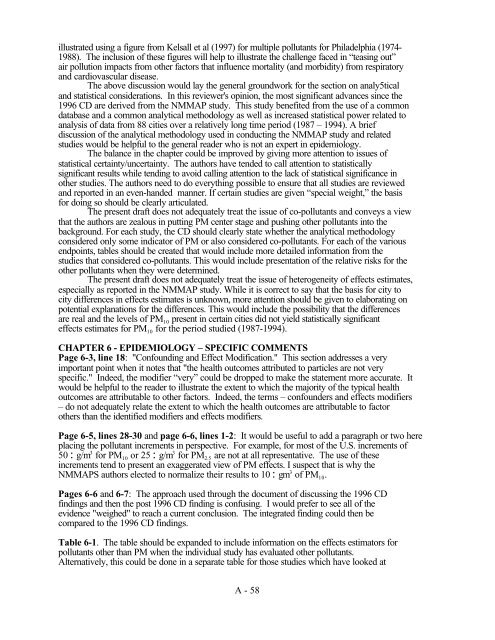Review of the Air Quality Criteria Document for Particulate Matter
Review of the Air Quality Criteria Document for Particulate Matter
Review of the Air Quality Criteria Document for Particulate Matter
- No tags were found...
Create successful ePaper yourself
Turn your PDF publications into a flip-book with our unique Google optimized e-Paper software.
illustrated using a figure from Kelsall et al (1997) <strong>for</strong> multiple pollutants <strong>for</strong> Philadelphia (1974-1988). The inclusion <strong>of</strong> <strong>the</strong>se figures will help to illustrate <strong>the</strong> challenge faced in “teasing out”air pollution impacts from o<strong>the</strong>r factors that influence mortality (and morbidity) from respiratoryand cardiovascular disease.The above discussion would lay <strong>the</strong> general groundwork <strong>for</strong> <strong>the</strong> section on analy5ticaland statistical considerations. In this reviewer's opinion, <strong>the</strong> most significant advances since <strong>the</strong>1996 CD are derived from <strong>the</strong> NMMAP study. This study benefited from <strong>the</strong> use <strong>of</strong> a commondatabase and a common analytical methodology as well as increased statistical power related toanalysis <strong>of</strong> data from 88 cities over a relatively long time period (1987 – 1994). A briefdiscussion <strong>of</strong> <strong>the</strong> analytical methodology used in conducting <strong>the</strong> NMMAP study and relatedstudies would be helpful to <strong>the</strong> general reader who is not an expert in epidemiology.The balance in <strong>the</strong> chapter could be improved by giving more attention to issues <strong>of</strong>statistical certainty/uncertainty. The authors have tended to call attention to statisticallysignificant results while tending to avoid calling attention to <strong>the</strong> lack <strong>of</strong> statistical significance ino<strong>the</strong>r studies. The authors need to do everything possible to ensure that all studies are reviewedand reported in an even-handed manner. If certain studies are given “special weight,” <strong>the</strong> basis<strong>for</strong> doing so should be clearly articulated.The present draft does not adequately treat <strong>the</strong> issue <strong>of</strong> co-pollutants and conveys a viewthat <strong>the</strong> authors are zealous in putting PM center stage and pushing o<strong>the</strong>r pollutants into <strong>the</strong>background. For each study, <strong>the</strong> CD should clearly state whe<strong>the</strong>r <strong>the</strong> analytical methodologyconsidered only some indicator <strong>of</strong> PM or also considered co-pollutants. For each <strong>of</strong> <strong>the</strong> variousendpoints, tables should be created that would include more detailed in<strong>for</strong>mation from <strong>the</strong>studies that considered co-pollutants. This would include presentation <strong>of</strong> <strong>the</strong> relative risks <strong>for</strong> <strong>the</strong>o<strong>the</strong>r pollutants when <strong>the</strong>y were determined.The present draft does not adequately treat <strong>the</strong> issue <strong>of</strong> heterogeneity <strong>of</strong> effects estimates,especially as reported in <strong>the</strong> NMMAP study. While it is correct to say that <strong>the</strong> basis <strong>for</strong> city tocity differences in effects estimates is unknown, more attention should be given to elaborating onpotential explanations <strong>for</strong> <strong>the</strong> differences. This would include <strong>the</strong> possibility that <strong>the</strong> differencesare real and <strong>the</strong> levels <strong>of</strong> PM 10 present in certain cities did not yield statistically significanteffects estimates <strong>for</strong> PM 10 <strong>for</strong> <strong>the</strong> period studied (1987-1994).CHAPTER 6 - EPIDEMIOLOGY – SPECIFIC COMMENTSPage 6-3, line 18: "Confounding and Effect Modification." This section addresses a veryimportant point when it notes that "<strong>the</strong> health outcomes attributed to particles are not veryspecific." Indeed, <strong>the</strong> modifier “very” could be dropped to make <strong>the</strong> statement more accurate. Itwould be helpful to <strong>the</strong> reader to illustrate <strong>the</strong> extent to which <strong>the</strong> majority <strong>of</strong> <strong>the</strong> typical healthoutcomes are attributable to o<strong>the</strong>r factors. Indeed, <strong>the</strong> terms – confounders and effects modifiers– do not adequately relate <strong>the</strong> extent to which <strong>the</strong> health outcomes are attributable to factoro<strong>the</strong>rs than <strong>the</strong> identified modifiers and effects modifiers.Page 6-5, lines 28-30 and page 6-6, lines 1-2: It would be useful to add a paragraph or two hereplacing <strong>the</strong> pollutant increments in perspective. For example, <strong>for</strong> most <strong>of</strong> <strong>the</strong> U.S. increments <strong>of</strong>50 :g/m 3 <strong>for</strong> PM 10 or 25 :g/m 3 <strong>for</strong> PM 2.5 are not at all representative. The use <strong>of</strong> <strong>the</strong>seincrements tend to present an exaggerated view <strong>of</strong> PM effects. I suspect that is why <strong>the</strong>NMMAPS authors elected to normalize <strong>the</strong>ir results to 10 :gm 3 <strong>of</strong> PM 10 .Pages 6-6 and 6-7: The approach used through <strong>the</strong> document <strong>of</strong> discussing <strong>the</strong> 1996 CDfindings and <strong>the</strong>n <strong>the</strong> post 1996 CD finding is confusing. I would prefer to see all <strong>of</strong> <strong>the</strong>evidence "weighed" to reach a current conclusion. The integrated finding could <strong>the</strong>n becompared to <strong>the</strong> 1996 CD findings.Table 6-1. The table should be expanded to include in<strong>for</strong>mation on <strong>the</strong> effects estimators <strong>for</strong>pollutants o<strong>the</strong>r than PM when <strong>the</strong> individual study has evaluated o<strong>the</strong>r pollutants.Alternatively, this could be done in a separate table <strong>for</strong> those studies which have looked atA - 58
















